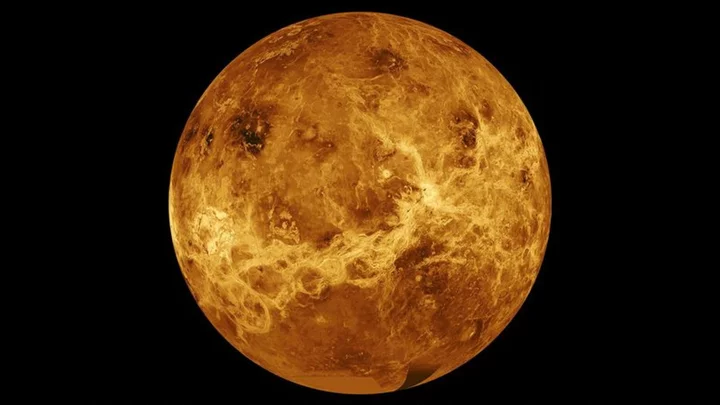By Will Dunham
WASHINGTON Oxygen accounts for about 21% of Earth's air, with the rest of our atmosphere primarily nitrogen. And most living things - including people, as we well know - need oxygen to survive.
Earth's planetary neighbor Venus offers quite a different story. Its thick and noxious atmosphere is dominated by carbon dioxide - 96.5% - with lesser amounts of nitrogen and trace gases. Oxygen is nearly absent. In fact, with Venus getting far less scientific attention than other planets such as Mars, the direct detection of its oxygen has remained difficult.
Using an instrument aboard the SOFIA airborne observatory - a Boeing 747SP aircraft modified to carry an infrared telescope in a joint project between NASA and the German Aerospace Center - scientists have now detected atomic oxygen in a thin layer sandwiched between two other layers of the Venusian atmosphere.
They noted that this atomic oxygen, which consists of a single oxygen atom, differs from molecular oxygen, which consists of two oxygen atoms and is breathable.
The researchers directly detected oxygen for the first time on the side of Venus facing the sun - where it actually is produced in the atmosphere - as well as detecting it on the side facing away from the sun, where it previously was spotted by a ground-based telescope in Hawaii. Venus rotates much more slowly than Earth.
"The Venus atmosphere is very dense. The composition is also very different from Earth," said German Aerospace Center physicist Heinz-Wilhelm Hübers, lead author of the study published in the journal Nature Communications.
The thick atmosphere on the second planet from the sun traps in heat in a runaway greenhouse effect.
"Venus is not hospitable, at least for organisms we know from Earth," Hübers added.
The oxygen is produced on the planet's day side by ultraviolet radiation from the sun that breaks down atmospheric carbon dioxide and carbon monoxide into oxygen atoms and other chemicals, the researchers said. Some of the oxygen is then transported by winds to the Venusian night side.
"This detection of atomic oxygen on Venus is direct proof for the action of photochemistry - triggered by solar UV radiation - and for the transport of its products by the winds of Venus' atmosphere," said astrophysicist and study co-author Helmut Wiesemeyer of the Max Planck Institute for Radio Astronomy in Germany.
"On Earth, our life-protecting stratospheric ozone layer represents a well-known example of such photochemistry," Wiesemeyer added.
On Venus, there is a layer of clouds containing sulfuric acid up to a height of about 40 miles (65 km) above the planetary surface, with hurricane-force winds blowing in the opposite direction of the planet's rotation. About 75 miles (120 km) above the surface, strong winds blow in the same direction as the planet's rotation.
The oxygen was found to be concentrated between those two ferocious layers, at an altitude about 60 miles (100 km). The oxygen's temperature was found to range from about minus 184 degrees Fahrenheit (minus 120 degrees Celsius) on the planet's day side to minus 256 degrees Fahrenheit (minus 160 degrees Celsius) on its night side.
Methods used previously to detect Venusian oxygen on the day side were indirect, based on measurements of other molecules in combination with photochemical models.
Venus, with a diameter of about 7,500 miles (12,000 km), is slightly smaller than Earth. In our solar system, Earth resides comfortably within the "habitable zone" around the sun - the distance considered not too close and not too far from a star to be able to host life, with Venus near the inner boundary and Mars close to the outer edge.
"We are still at the beginning of understanding the evolution of Venus and why it is so different from Earth," Hübers said.
(Reporting by Will Dunham, Editing by Rosalba O'Brien)

